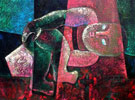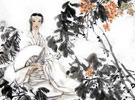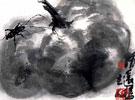Found Art Museum is honored to continually recommend abstract artists who are provided with local linguistic features. Qu Qianmei has lived in France for years. While she lived in Paris, she was reclusive to pursue artistic creation in painting for more than twenty years with the artistic atmosphere in Paris nourishing inner creative passion and persistent artistic pursuit toughening her works. She experiences the similarities and differences between Chinese and Western cultures to taste their foundations. Thereby artistic essences lie in these two kinds of worlds are condensed in her huge abstract paintings which possess Eastern philosophy.
During her earlier stage of career, Qu Qianmei has devoted to Chinese paintings at her hometown among the area of Jiangsu and Zhejiang provinces, where delicately beautiful landscapes and soil nourished her artistic sensibility and gave birth to her temperament like traditional literati or scholar-bureacrats who linger about mountains and rivers while possessing perception of the supernatural as well as abstract understanding of the nature. As a result, her creations are naturally inclined to be plane, simple and abstract freehand works.
As a female artist in painting, she does not stay superficially in the leisurely complex of hiking tour. When Chinese artistic circle was undergoing radical changes in the mid-1980s, she was not limited in the fanatical passion of “85 New Wave” art movement but travelled to France for learning arts with the idea of holding broaden horizons abroad. This choice has increased her insight and vision. In Paris, the panoramic view on realistic features of Western art could be gotten, however, what’s on earth the essential difference between the Chinese abstract art and Western local abstract art on shelf? After she has visited the exhibition of Tapies (Born in 1923 in Barcelona, Spain, Antonio Tapies is one of western masters in painting who are provided with oriental philosophy.), Qu Qianmei more profoundly reflects on the directions of abstract art. She gradually puts down the brushes of traditional Chinese paintings while turns to explore her independent art space on linen.
She begins to cling to studies on materials and media and then continues her in-depth exploration in forms of painting through media itself. However, quite different from explorations which pursued by domestic “avant garde” artists who were born in 1980s and 1990s, Qu Qianmei quietly solved the relationship between linen and depiction of spiritual freedom in France; she also explored abstract paintings’ meaning of existence and its innovation as an independent long-standing form. From this perspective, her paintings are elaborative absolutely abstract paintings which direct to spiritual demands. Nevertheless, her abstract art contains unabated consciousness of “Oriental philosophy”. Years of life in France could not change her national habit of thinking—fortunes in her heart, mental realm and expression of intentions with paintings have been something upheld by her all the time. Therefore, even Qu Qianmei’s works wander among western systems of creation they still reveal profound bosom and ethereal changing colors of the Oriental Art.
In the general appearances of her paintings, the expatiation of special materials, irregular symbols and hidden figures all arouse audience’s curiosity for the logics and conception behind the works. Thickness of the materials directly reinforces your thinking power. Just as you face this work, your imagination is immediately inspired to explore sense corners usually neglected. This process of comprehension is more like a kind of “self-discover” rather than simple appreciation—by the “material” in her painting materials it prompt access to their subconscious mind for emotional and rational dialogue—this is the ultimate goal of Chinese ancient artists in paintings who combine nature and heart to be sensitive to the circumstances and express feelings.
Full of enthusiasm as well as in peaceful mood and experience which is the psychological form of common needs nowadays, Qu Qianmei’s works are created as abstract works of tremendous freehand.
Shi Liren




